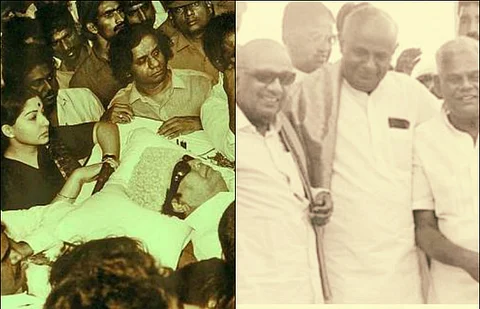

As DMDK and People's Welfare Alliance announced on Wednesday that they would face the Tamil Nadu elections together, the media and social media users were buzzing with excitement over the four or five-cornered fight. Many called it a new phenomenon for Tamil Nadu.
1989 - Tussle for MGR's legacy
Over the years, though the Tamil Nadu elections have been largely bipolar, this will be the third time the state will witness a multi-cornered fight – DMK-Congress, NDA, AIADMK, PMK and DMDK-PWF. Previously, the 1989 and 1996 elections earned the distinction of an interesting four-pronged fight, and this time it's five fronts fighting it out.
During the 1989 assembly polls, which the DMK comfortably won, factionalism in the AIADMK after MG Ramachandran’s death led to Janaki floating ADMK (JR) and Jayalalithaa floating ADMK(JL), and DMK and Congress going alone. It was a test for the four parties, with the prestige of Rajiv Gandhi in particular, apart from M. Karunanidhi and Jayalalithaa were put to the test. More importantly, the election was the decider on who the true heir of M.G. Ramachandran's legacy would be - his wife Janaki, or his protege Jayalalithaa. And Jayalalithaa emerged victorious of the two winning 27 seats while Janaki's party won just two.

Image Courtesy: Veejay Sai
The DMK had three partners in its alliance, while the Congress(I) had roped in six small parties, including religion-based organisations such as a faction of the Muslim League and the Christian Democratic Front. Jayalalithaa and Janaki had six and four partners in their front with Janaki teaming up with the breakaway faction of the Congress(I) led by Sivaji Ganesan. The three main chief-ministerial candidates were Karunanidhi. Jayalalithaa and PCC(I) chief G.K. Moopanar. DMK did a clean sweep, got 150 seats, and the Congress followed with 30 seats.
1996- An election of many breakaway parties
1996 denoted the fall from grace for Jayalalitha's AIADMK and the DMK was back in power with a whopping 173 seats. From holding an impressive 164 of the 234 seats in 1992 the ruling AIADMK plummeted to just four seats. The elections were fiercely fought between the AIADMK, the DMK-Tamil Maanila Congress, PMK-Tiwari Congress and Vaiko’s MDMK that had been floated in 1994. The DMK won by a landslide and the AIADMK earned the ire of party cadres.
This was an election that saw many breakaway parties. Tamil Maanila Congress, Pattali Makkal Katchi, Tiwari Congress and Marumalarchi Dravida Munnetra Kazhagam were formed, challenging the bipolar nature of the elections.

Though the AIADMK- Congress alliance had won and AIADMK formed the government in 1991, they had a fallout a year later. So during the 1996 polls, Congress cadres predicted a move towards the DMK. But when the party high command finally announced an alliance with the AIADMK, hell broke loose within the party, and Moopanar came to found the Tamil Maanila Congress joining with the DMK. In a matter of weeks, the party was founded and alliance made. Benefiting from the DMK's sweep, TMC won a good 39 seats.
DMK chief’s lieutenant, as he was known, Vaiko, had been expelled by the party. The relationship soured when Karunanidhi favouring his son M K Stalin overshadowed the affection he felt for his disciple. Vaiko questioned Karunanidhi when he made Stalin the second most important leader in the DMK, a position Vaiko had held till then. In 1994, Vaiko was expelled from the DMK for dissent. In protest, many DMK cadres left the party. The MDMK was born out of the frustration many DMK cadres had with the party patriarch's dynastic politics. The MDMK joined hands with the CPI(M) and Janata Dal, earning just one seat.
The Pattali Makkal Katchi was borne out of a series of agitations, part of which was to block roads with tree trunks and disrupting traffic. All the agitations had a single point agenda: Reservations and more reservations for the Vanniyars. Formed in 1989, this was the party’s first shot at the elections and had aligned with the Tiwari Congress, another breakaway party that was Vanniyar centric. How did they fare? This was the first and last election so far that the PMK contested without allying with a Dravidian party, winning four seats.
2016
Now that the DMDK and the PWF, which projected itself as Tamil Nadu's corruption-free alternative front have announced an alliance, smaller parties are scampering around to ally with the DMK, which has kept its doors open. The NDA seems largely set in stone for now. The PMK is still sticking to its stand of contesting alone. With five fronts in the running, a challenge to the bipolar nature of Tamil Nadu polls is being posed, and how.